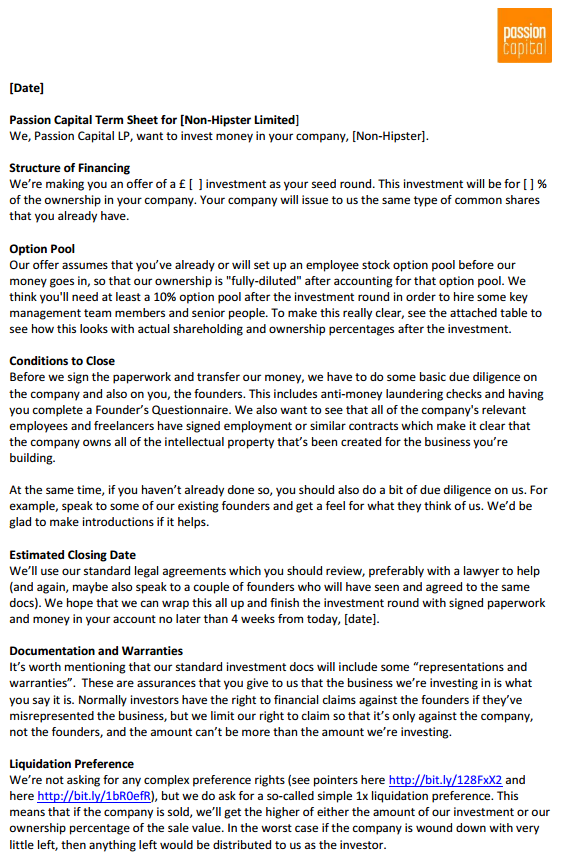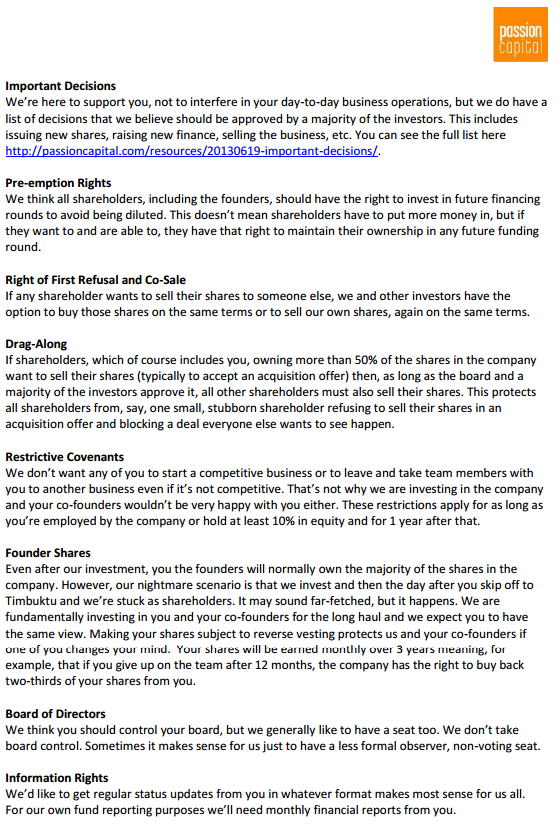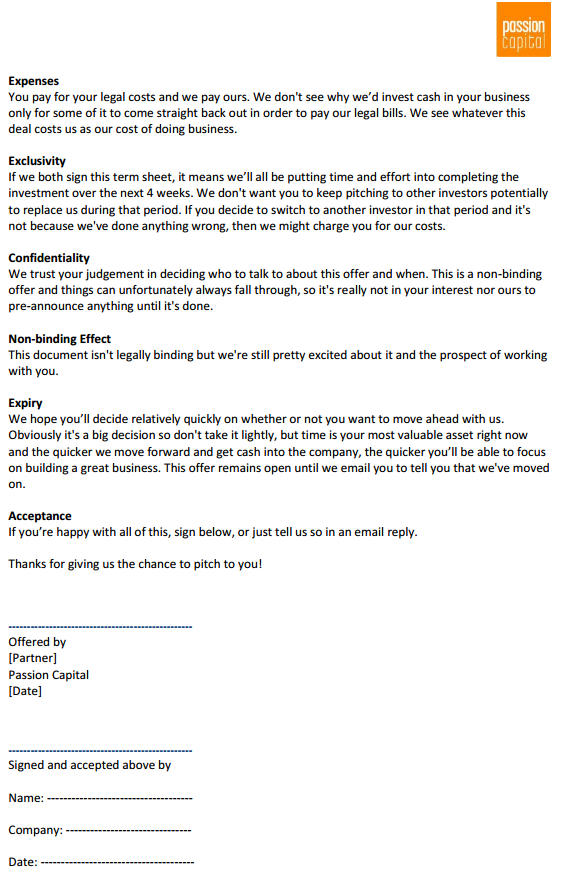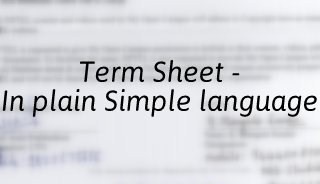I am putting this up specifically for Alok’s comment… Want to get his views..
Generally, for a first time entrepreneurs when they are presented with a Term sheet, they are unable to understand it completely. To overcome this problem, a London based Angel Investment firm Passion Capital came up with a new format of Termsheet which has been put across in “plain simple English”, so even a novice can understand it.
Wanted to know if this will really work? Here is the template.
Term Sheet – In Plain Simple English









Alok Rodinhood Kejriwal
I dont agree with this.
For the following reasons:
– Any document that is put out by a serious, well funded and highly respectable VC is a legal, binding document. And when such firms put out serious documents, they have to be legally vetted and ‘court and law proof’.
Example:
The document above says “If you skip and go to Timbuktu’ then restrictive covenants kick in. So what happens if i go to LA? Am I scot free (Think of arguing this in the Mumbai High Court where every word is taken for what it means)
Does that not make the covenants kick in?
– Most VCs HAVE TO get such documents written by lawyers and no lawyer worth his stale “AAM KA ACHAR” will write the gooey stuff above.
– Term sheets GET CONVERTED To Share Holding Agreements AND Share Subscription agreements and they sound LEGAL AS HELL. So what’s the big deal if the preamble (Term Sheet) is shitty too?
Its better for an entrepreneur to get used to legalese at term sheet level than when the SHA and SSA arrive.
Else, it will be like going from kindergarden to MIT
– TRUST ME, the entrepreneur can ALSO insert nice protection clauses in docs. This HELPS and is only possible when working with a legally valid document.
Consider these as examples:
********
Case Study 1 – The 3 hidden weapons in Term Sheets:
Once upon a time, in a land not so far away, two dynamic entrepreneurs – Bakra and Bakri got together and started up an amazing e-commerce business to sell sheep wool online! Within a few months their business was rocking; orders were pouring in from all over the world, page views & comScore numbers were soaring and the servers and the site were happily crashing. This was indeed a great start up.
One day, on a midsummer night, they heard a knock on their cottage door, and when they opened it, a dark skinned man in a black suit, black shoes and black umbrella, with gelled black hair, holding a black satchel greeted them.
‘Hi’ he said, ‘My name is VC, and I am here to fund you’.
Over the next few days, VC patiently explained how he would invest his humongous dollars into Bakra and Bakri’s start up, so as to scale it and make it profitable and ‘Nasdaq’able’.
On the final day, VC didn’t meet them, but sent them a terse mail that read ‘Term Sheet attached. Sign and Return’.
Bakra and Bakri were innocent entrepreneurs and decided to forward the same mail to Rodinhood – the Prince of Entrepreneurs who lived in the Forest of Enterprise.
When Rodinhood read the term sheet, he found the same 3 deadly weapons he had suspected – well concealed and embedded inside the document. These, if not disengaged, could kill or at least severely damage Bakra and Bakri’s economic progress.
This is what he identified:
1. The Shot Gun: The ESOP carve out Clause
In the clause of ‘ESOP’ or employee stock option plan, the term sheet stated that the entrepreneurs (B&B) would carve out 10% of the share of the Company PRIOR to the funding. The weapon was the word PRIOR. It meant that B&B would have to further dilute 10% of their OWN stocks to make way for future employees, (who would work for the Company and actually benefit all the owners).
In his explanation Rodinhood wrote to B&B that the carve out of ESOP’s PRIOR to the funding was unfair on two counts:
a) It should come from the share of every owner of the company’s share and hence POST not PRIOR to the funding since the benefit accrues to all owners as the company grows.
b) In case of non-allotment of the complete 10%, the Investors would share the residual shares as well! Hence this was an indirect ploy to get more shares of the promoters under the guise of an ESOP plan.
Rodinhood’s final advise was – Try and negotiate esop dilution after funding and limit the commitment to 5% to begin with, since no one knows at the start of a business what really the esop pool requirement will be.
2. The Samurai Sword – The Liquidation Preference Multiple Clause
The term sheet stated that on liquidation of the Company, the VC would receive 2x of the money invested.
This meant that upon Liquidation (and this interpretation could include an exit), the VC would first take home not just the amount invested in the Business but DOUBLE of the same – so 2x of the investment!
Hence, no matter what the outcome, the VC would enjoy a 100% return on his investment; Bakra and Bakri would be left with what remained if anything at all.
Rodinhood’s comment was that if VC means Venture Capital, it should remain Venture Capital and not Vampire Capital. Hence, the fair multiple was 1x of the principal back and NOT 2x or 3x etc, etc, in favor of the VCs. 1x ensured return of Capital and nothing more if the Company was sold in extraneous circumstances.
3. The Nuclear Bomb – the Preferred and Participating Clause
In this Term Sheet, the clause ‘Preferred and Participating’ made Rodinhood’s Marwari blood boil. This was the classic nuclear bomb aimed at the entrepreneurs.
It meant that in case of a sale, FIRST the VC would take home 2x of his investment. Then, on the remainder, the VC would take his legitimate %.
So, assume that Bakra and Bakri’s Company raised Rs 100 from VC at a 30% dilution.
Also let’s assume that after 4 years, the business would sell at Rs 800.
Logically, VC would take home 30% of Rs 800 or Rs 240? Correct?
Wrong!!
Under the preferred and participating this is what would happen:As per the ‘Preferred’ clause, VC would first take home 2*100 (2x liquidation preference) = Rs 200.
As per the ‘Participating’ clause, OF THE MONEY THAT REMAINED – Rs 600, VC would take home 30% or Rs 180.
Hence the total money that the VC would take home would be 200+180 = 380 instead of 240!
In other words, the Equity of VC just became 47.5% rather than the original 30% only because of this Draconian Clause.
Rodinhood sent his comments back to Bakra and Bakri with the above explanations and the final advise – ‘no matter what anyone tells you, including myself – do what’s right for yourself and your business. Just try and remove or disengage these weapons as best as you can. Always remember –when you have a good thing going, capital chases entrepreneurs and you must negotiate justly and hard!
******
Case Study 2 – The 6 deadly weapons in Share Holding Documents.
Bakra &Bakri (B&B) – two successful entrepreneurs had just started an e-commerce business to sell their sheep wool online and were a happy lot. They had negotiated their term sheet with Mr. VC (read the prequel to this story) and were sitting back in their cottage backyard, nursing single malts. They always drank “Ballantine 17 years”.
Bose’s garden speakers were playing ‘don’t stop thinking about tomorrow’ by Fleetwood Mac.
Bakra’s iPhone beeped; a message from the VC read ‘Check mail. SHA attached’.
Even while he was pulling away the wool from his eyes, Bakra forwarded the sms and the mail to Rodinhood – the Prince of Entrepreneurs who lived in the forest of Enterprise. Rodinhood was a friend of all the Bakras and Bakris who guided and consulted entrepreneurs in their start up life.
Rodinhood read the message and immediately got down to work.
As he opened the SHA (share holders agreement), he took a deep breath. This was the most important document for any entrepreneur and he was determined to be thorough and fair in his perusal and remarks.
1) Definitions.
First Rodinhood carefully went through the ‘Definitions or ‘Recitals’ – the bullet like descriptions of key terms in the beginning of the agreement and made sure that they were in order. For instance, Rodinhood checked the definition of ‘FMV’ (Fair Market Value) and checked it read fairly. The recitals are important because there are acronyms used multiple times across the agreement and these acronyms are detailed in the recitals.
Rodinhood considered the definition of ‘Control’ and checked if the explanation defined Control as 50% or 51% or was it a loose, under defined meaning. Each interpretation of the definition of control for instance had a different outcome in the long term.
To keep himself relaxed, Rodinhood was sipping Perrier on the rocks, in his favorite rock glass, garnished with a twist of Lime. Beethoven’s Emperor Concerto was playing in the background. The atmosphere was ‘cordial’ enough to come to terms with an SHA.
2) Pre Emptive Rights.
Swiftly, Rodinhood came across ‘Pre Emptive Rights’ (the terms that allowed existing shareholders to participate in a new issue first) – and they seemed fine. But he still went through the section once again.
3) Representations and Warranties.
On Reps and Warranties – Rodinhood made a side note to ask Bakra and Bakri if they had ‘shared’ everything with Mr. VC?
Rodinhood always believed that it was most prudent to reveal everything about the Company to an investor BEFORE taking in their money. If there were secret promoters or other shareholders, they ought to be made public and given shares before the Company was finally structured. Also, if the Company had received some vague legal threat or was under the cloud of potential litigation, it was most important to reveal it all to the VCs. Thinking ‘let me handle this after I get the money in the bank’ is suicidal for entrepreneurs.
In Reps and Warranties, Rodinhood wondered how Bakra and Bakri had reflected their personal loans invested in the Company and what was their agreement with the VC. Rodinhood personally had a view that all ‘moneys’ of entrepreneurs into their own Company be treated as loans and returned gently over a period of time; post funding. Rodinhood felt that his concept was right because the entrepreneurs were putting in their sweat, blood and tears into this start up which was way beyond a few lacs of money. Besides moneys taken from relatives, friends and even piggy bank savings were best returned to entrepreneurs so that they could focus solely on the business.
The rock glass was sweating as the ice and Perrier got acquainted. The lime slice was quickly become the stranger in the mix.
4) Restrictions on Transfer of Shares.
Was the next section that made Rodinhood sit up. This SHA locked 75% of the entrepreneurs’ shares in an escrow to be earned back by the entrepreneurs over a period of 3 years.
While Rodinhood accepted that VCs needed to ‘lock-in’ entrepreneurs by locking in their entrepreneur shares over the next few years in the Company (post its funding so as to protect the VC’s from founders just walking away), Rodinhood always had the following tenets for entrepreneurs:
Rodinhood’s rational on fair pricing for the exit price of the promoter (in such extraneous events) was the logic that a lot could happen in 3 years. The industry could change tremendously – the VC’s and other founders may completely want to take the business in another direction. Hence it was important that the VALUE created at the time of departure of the promoter be captured and handed over to her.
The agreement was now half way reviewed and Rodinhood took a break to stretch his legs. He changed the Emperor Concerto that had just finished playing the second time to Mahler’s Syphony No 1 ‘The Titan’. Rodinhood needed his favorite symphony to give him a natural high at this point.
5) TAG ALONG rights.
In this SHA, the tag along rights read like they always did.
Rodinhood had one very important point on this. In the part where it was clear that the investors could ‘tag along’ with the promoter in the event that the promoter was selling and the investors also wanted to exit, Rodinhood made sure that in the event of less than a 100% exit of all shares, everyone in the Company sold their shares pro-rata.
To explain his point, Rodinhood added this side note to Bakra and Bakri (B&B):
Imagine if after a few years, your business is doing well, and you meet a Company called Goat and Sheep (G&S) of Britain who have a similar business like yours; but their business is much larger and is publicly listed. G&S love what B&B do and the fact that B&B are in India – so offer to buy B&B out. However, they want only 51% of the Company. As per the existing ‘Tag Along’ rights, while you (B&B) make the effort of finding an acquirer and negotiating the best price, the B&B Company investors (who say would own 60% of the Company) will have the rights to TAG ALONG with B&B.
In the present agreement, the investors in B&B had the Tag Along rights to offer their ENTIRE portion of shares first and then allow the rest to be sold by B&B. Given that 51% was being bought out, it would mean that none of Bakra and Bakri’s shares would be acquired by G&S! This will leave B&B stuck with the Goat and Sheep Company who would never offer to buy B&B’s remaining shares out!
So, in the event of a partial sale, it was critical to negotiate ‘pro-rata’ tag along rights so that in case of, say 51% being acquired by Goat and Sheep, EVERYONE in the B&B Company has a right to tag along – thereby benefiting promoters, investors and of course ESOP share holders. This pro rata tag-along was very important when strategic companies acquired operating firms.
Rodinhood took the last swig of what remained of the Perrier and chewed on the ice cubes that had come along. The twisted lime now looked like a complete stranger in the glass.
6) DRAG ALONG rights.
Came next. Rodinhood thoroughly went through the clauses and they read exactly the way they were supposed to. He sighed. He had no comments to make on the same – despite having fought and won a bitter battle on these same rights. Just to make B&B understand the implications of DRAG ALONG – Rodinhood inserted a hyperlink of his classic blog post (the toughest decisio… relating to this subject for Bakra and Bakri’s reference reading and left it at that.
The rest of the document read fine. Rodinhood made sure to point out that it was nice to keep the Board as small as possible (two from the promoters side and one from the investors), so as to be able to accommodate a larger board with subsequent investments.
Finally, Rodinhood made a footnote for B&B to diligently make sure that the Conversion, Liquidation Preference and ESOP clauses were in accordance with what was negotiated in the term sheet. These 3 terms were as important as the 6 terms described above.
The evening had burst into the night. Rodinhood smiled as he mailed the SHA with his remarks to Bakra and Bakri. He was happiest helping fellow entrepreneurs and this was truly one of those moments.
*****
Nitin Pulyani
Wow!!! This is ultra useful. This is the “ultimate kunji” that one should take a print of and read along side the actual term sheet. This is the English translation of the term sheet. Thanks Alok!
Darshan Bhambiru
Whoa!!! Can we Please have this Post Pinned or Sticky!!!
The Post Trauma Scene, after the Entrepreneur gets Funded or is Ready to be Funded – Demystified!!!
We needed something like this from a long time here!!
Thanks to Arun and Alok made it an “A” class post, am sure now!!
Has to be Bookmarked for Future references – Part of the Arsenal now!! 🙂
Arun Prabhudesai
Alok – Awesome… and thanks a ton for being so detailed about it….
Term Sheet Demystified. I think if anyone wants to know anything about Term Sheet… This is the page they should visit… By the end of it, I am sure they will be ready with everything..
Thanks Alok…
Gunjan Kejriwal
Thank You !
Pankaj Bakal
Alok sir…u’re really a lifesaver for the first timers…what an explanation…hats off 🙂
Anand Shukla
Great info Alok. Thanks a lot.
Kasthuri Kumaran
A clever attempt in plain English to phish by passionate capitalist cronies!
Brilliantly crafted – alas, they have left their cracks open for anyone with a little intelligence to peep through the holes!
Omkar Sapre
Alok,
The plain English version says non-legally binding. Does it mean the plain English version or are actual legalese term-sheets are too not binding legally? What’s the logic of signing then? And you also referred to high court. Can you please throw some light on this?
Vikram Parekh
Great stuff. Thanks Alok.
Nand Kumar Sherman
How I wish all funders come up with such simple terminology!! I wonder however whether that will ever happen soon enough.
In the meantime anyone wants help in deciphering term sheets, do feel free to reach out to me.
Cheers